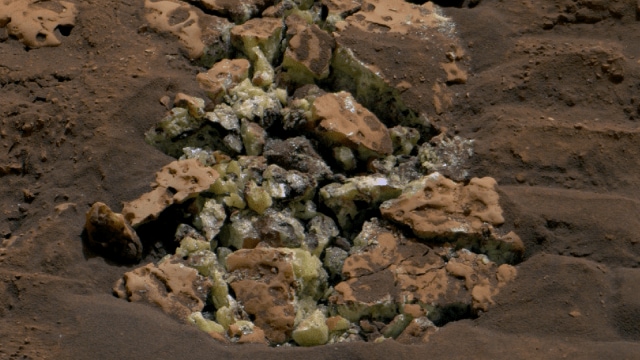NASA’s Curiosity Rover finds yellow pure sulfur crystals on Mars
There are many rocks constraining sulphate, a type of salt made from the chemical, but this is the first time someone has stumbled across yellow-coloured pure sulfur crystals.
 Gediz Vallis channel is one of the main reasons why scientists sent the Curiosity rover to Mars. (Image Source: NASA)
Gediz Vallis channel is one of the main reasons why scientists sent the Curiosity rover to Mars. (Image Source: NASA)For almost a decade, NASA’s Curiosity Rover has been climbing the foothills of Mount Sharp, a pretty large mountain on Mars that stands tall above an ancient crater. In the last few years, the four-legged rover revealed a lot of things about the planet humans might someday call home, but this is the first time it has stumbled across a field of rocks made of pure sulfur.
According to NASA, a rock Curiosity recently drove over suddenly cracked open to reveal these yellow sulfur crystals. Since October last year, the rover has been exploring a region of Mars filled with sulphates, a type of sulfur-based salt that is formed by the evaporation of water.
The discovery of pure sulfur is one of the several ones made by Curiosity since it started off-roading in the Gediz Vallis channel, a groove that goes down the 5 km tall Mount Sharp. NASA says that Curiosity’s mission is to study where and when the red planet’s terrain may have the nutrients required to sustain microbes and that every layer of the mountain gives us a glimpse of the planet’s history.
Scientists say the Gediz Vallis channel is one of the main reasons why they sent the Curiosity rover to Mars. Since the rover started ascending the mountain earlier this year, scientists have been trying to determine if ancient floodwaters or landslides are responsible for the large mounds of debris that have built up over time.
Some recent clues suggest that both phenomena had an important role to play adn that while some piles were formed by the violent flow of water along with debris, others are caused by local landslides.
While previously found sulfur rocks were small and brittle to be extracted using a drill, scientists recently stumbled across a large rock, which they named ‘Mammoth Lakes’. Scientists then determined a safe part of the rock they could drill on the sloping surface.
“Finding a field of stones made of pure sulfur is like finding an oasis in the desert. It shouldn’t be there, so now we have to explain it. Discovering strange and unexpected things is what makes planetary exploration so exciting”, said Ashwin Nasavada, a scientist at NASA’s Jet Propulsion Laboratory in South California.







